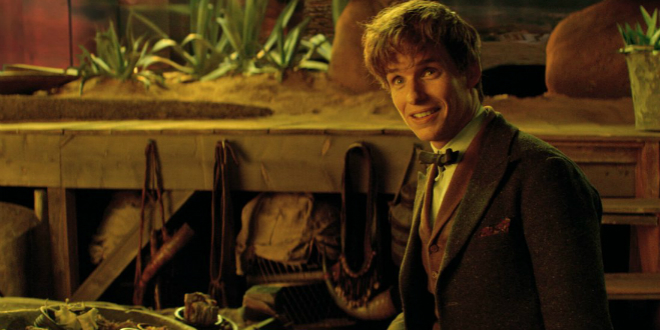Inside Newt’s Case: Dermot Power Reveals Secrets Behind “Fantastic Beasts” Concept Design
For many Fantastic Beasts fans, one of the film’s highlights was our first magical entrance into Newt’s suitcase. Seemingly innocuous on the outside, the scale of the imagination hidden within has surprised and entertained theater-goers around the world, and as Jacob says, “I ain’t got the brains to make this up!”
But this world was made up, and not solely by J.K. Rowling. As the screenwriter, she laid the groundwork for the scenes, setting out the magical principles, but the visuals were developed by the film’s design teams and led by Stuart Craig. And this development stage was far from a linear process.
Dermot Power, concept artist on Fantastic Beasts and three Harry Potter films, spoke in length at a recent Waterstone’s Piccadilly event about the different directions they took when imagining Newt’s world.
.@mark_salisbury, @IanNathan2 & @dermotpower take their seats @WaterstonesPicc to discuss #FantasticBeasts companion books. pic.twitter.com/QIyerqdb1X
— ᴍᴜɢɢʟᴇɴᴇᴛ ʟɪᴠᴇ (@MuggleNetLive) December 2, 2016
They initially focussed on Newt’s shed, an element of the design that Dermot himself was given responsibility for.
He wanted to recreate the look of “an old labour shed inside” with the appearance of a weather-beaten beach hut on the exterior. Original designs went as far as putting the shed on large sand dunes.
After various drafts, Stuart Craig reviewed them and encouraged Power to “make it more unusual,” pushing the design to become more twisted and elongated. It was this element of the design that creates the sense of a drop from the case entrance to the floor of the shed. There are hidden features all along the walls, but like most of the details in these films, they are forsaken for the need to focus on the narrative. (All the more reason to peruse the companion books!)
Of course, the shed is only the entrance to this world. The plans for the interior landscapes and environments were too varied and sprawling for Dermot to cover in one talk, but there was one notable feature that stood out.
During pre-production, the team identified Newt as a gatekeeper to this land, his Eden, but it soon became apparent that he created it. So if forged and governed by Newt, how would this be compiled?

The concept team began to create an actual world for Newt, a globe with compartments, or “cells,” for each of the beasts that he could pull toward him as and when needed. They were incredibly excited by this concept, with some of the technical team already contemplating how best to realize this piece of magical machinery, when Heyman presented it to Rowling, and it was shot down!
“It was too complicated.” Rowling elaborated further, explaining that Newt couldn’t have created such magic since he “isn’t that good a wizard.”
Momentarily stumped, the creative teams soon took to exploring what Rowling meant by these words and how this intent could inform their new design. Newt may not be a brilliant wizard, but he loves his beasts, and their care is his priority. Realizing this made the subsequent designs much easier. Power and the rest of the team began developing the environments that can be seen in the film, spaces that were enough to contain and satisfy the beasts but weren’t so magical that they would “distract Newt from his job” of caring for them. Similarly, the look and behavior of the beasts, designed simultaneously by a separate team, and their interaction within their individual environments, further informed the world’s creation.
"To do good design, you need to understand the narrative." @dermotpower on curating the #FantasticBeasts art book & developing concept art.
— ᴍᴜɢɢʟᴇɴᴇᴛ ʟɪᴠᴇ (@MuggleNetLive) December 2, 2016
It’s this process of understanding the narrative and characters of a story that Power believes makes for great design, something most Fantastic Beasts fans would surely agree they have more than achieved with this film.
Why buy the #FantasticBeasts companion books? They "flesh the world out", "push it further" and show more than can ever be seen in the film. pic.twitter.com/j3icjFouco
— ᴍᴜɢɢʟᴇɴᴇᴛ ʟɪᴠᴇ (@MuggleNetLive) December 2, 2016
For more on the making of Fantastic Beasts, check out Dermot Power’s book, The Art of the Film: Fantastic Beasts and Where to Find Them, along with the additional companion books, Inside the Magic: The Making of Fantastic Beasts and Where to Find Them and The Case of Beasts: Explore the Film Wizardry of Fantastic Beasts and Where to Find Them.
And for more Beasts news, reviews and epic discussions, have a listen to our Fantastic Beasts podcast, SpeakBeasty.

